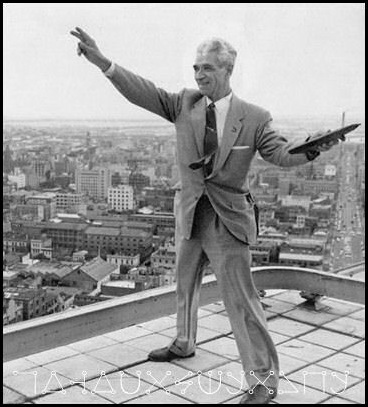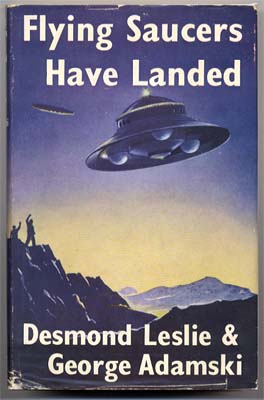
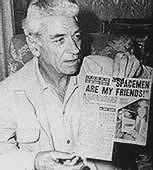
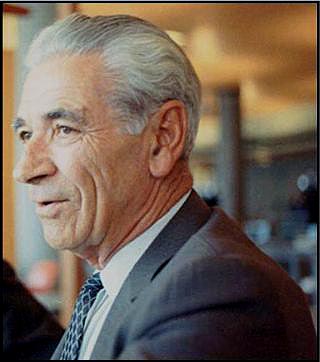
 |
 |
 |
One of the defining moments of 20th Century pseudoscience occurred in the fall of 1953 when Californian George Adamski modestly announced to the press that about a year previously (November 20, 1952) he had met and communicated with a man from Venus! This historic event had taken place at Desert Center, CA, in the presence of eyewitnesses! No sooner had the wire services distributed the story than a book co-written by Adamski appeared in stores— Flying Saucers Have Landed. Naturally, it sold fairly well.
|
Adamski was born on April 17, 1891, in Poland. He and his family moved to New York when Adamski was less than two years old, and he grew up in Dunkirk, NY, where economic hardship forced him to drop out of school in the 4th grade. In later years Adamski never wrote anything himself, preferring to dictate to a secretary, and it's possible he was a bit ashamed of his inability to spell simple english words. A few years before World War I, Adamski served in K-troop of the 13th US Cavalry, on the Mexican border. His tombstone lists his World War I military service as private, Company A, 23rd Batallion, US National Guard. He is supposed to have married Mary Shimbersky in 1917, but there is little or no reference to her in his subsequent history, although she seems to have stayed with him until her death, reportedly in 1954. After his marriage he did maintenance work at Yellowstone National Park, worked at a flour mill in Oregon, and did concrete contracting work in Los Angeles. In the early 1920s in California he seems to have been exposed to the I AM cult, and Katherine Tingley's version of Madame Blavatski's pseudoreligion of Theosophy, and in about 1926 or 1928 he began to found a succession of several Theosophy-based religious organizations of his own, the best known being the “Royal Order of Tibet,” whose so-called “monastery” was established at Laguna Beach sometime in the 1930s. Adamski, as contemporary newspaper accounts indicate, had grandiose plans for his cult, including the creation of a large campus like Katherine Tingley's Lomaland at Point Loma, CA. Surviving business cards, stationery and pamphlets from this period show that George was already referring to himself as “Professor” George Adamski. What he was a professor of, and who had awarded the degree, were unspecified! His elaborate plans came to nothing, and in 1939 or 1940 Adamski and his tiny flock of converts moved from Laguna Beach to a rural area near Mount Palomar, California, where they established a commune called “Valley Center,” where they lived under quite primitive conditions. In 1944 Adamski and his followers (then numbering less than a dozen in total) built and staffed a tiny hamburger stand at Palomar Gardens, on the lower slopes of Mount Palomar, beside the road leading up to the famed Observatories. Their still-primitive commune was relocated to the area behind the cafe, as seen from the road. Adamski began to hint that he was a “consultant” to the astronomers doing research on Palomar, and started referring to himself again as “Professor Adamski.” |
“Professor Adamski” and his 6-inch Newtonian reflecting telescope in 1952. 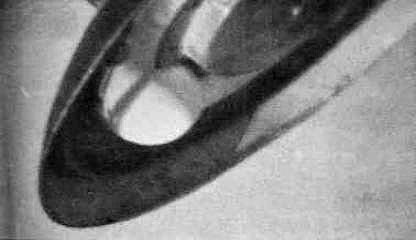 |
He made enough money to buy a 15-inch reflecting telescope which was protected within a small observatory shed, and began to talk about his important “astronomical research.” At some point he also accepted as a gift from a follower a 6-inch Newtonian reflecting telescope, which because it was readily portable was far more useful in establishing some of his later flying-saucer-related claims. It also had a camera attachment which used clumsy wooden Speed-Graphic-style film-holders.
On June 24, 1947, the flying saucer
myth first took wing with the report that a private pilot named
Kenneth
Arnold had seen a fleet of mysterious crescent-shaped
objects manuvering near Mt. Rainier in
Washington State. It was the gimmick that Adamski had been
searching for since his coming to California. Almost at once he
began to speak to his followers about telescopic observations of
cigar-shaped (and later disk-shaped) “spacecraft” from other
worlds, which he claimed to seen using both 15-inch and 6-inch
telescopes. He also claimed to have first spotted such
spacecraft nearly a year before Arnold, on October 9, 1946. His
followers today usually date his first photographs of saucers to
1948; the correct date seems to be 1949 - 50. His first
nationwide publicity came when an
article, illustrated with his saucer photos, appeared in
Ray Palmer's digest-sized FATE Magazine, July, 1951.
Adamski incorporated both his religious teachings and the 1948-era flying saucer myth into a science-fiction novel, Pioneers of Space: A Trip to the Moon, Mars and Venus,published in 1949 by a vanity press, Leonard-Freefield of Los Angeles. This novel was ghost-written by Lucy McGinnis, a follower whom Adamski had appointed his “secretary,” partly based on dictation from Adamski, and partly on previously-printed pamphlets expounding on Adamski's doctrines, which wildly mixed Theosophy and Christianity. The very poorly written novel tells of the first expedition from the earth to the moon, during which the earth explorers discover entirely human-looking inhabitants who turn out to live on every planet in our solar system. For the rest of the novel, the superhumanly wise extraterrestrials pontificate philosophically and religiously to the open-mouthed earthmen. Their teachings correspond precisely and specifically to those of Adamski's cult. Science fiction magazine editor Ray Palmer noted that Adamski had previously submitted short stories based on the same material, none of which were accepted for publication. It appears that everything that was issued under Adamski's name was ghostwritten by one or more followers. Desmond Leslie, in his revised edition of Flying Saucers Have Landed, published in 1970 after Adamski's death, refers directly to “Adamski's inability to write and speak good English,” and also interestingly comments that when he first met Adamski in the mid-1950s he was annoyed by Adamski's “traces of tiresome egotism.”
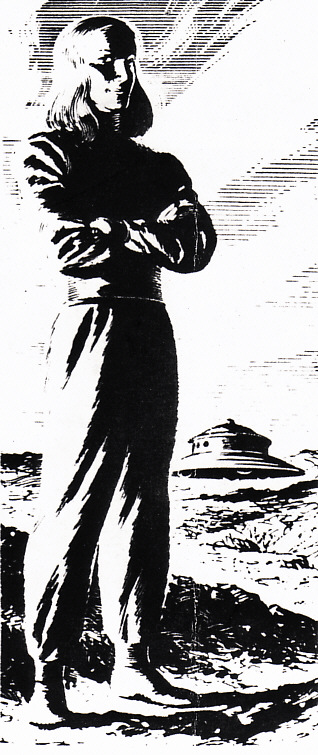
Orthon, the man from Venus, who appears to have tongue in cheek in this rendering. |
Adamski's first “nonfiction” book, Flying Saucers Have Landed (1953) is almost entirely a summary by British Theosophist Desmond Leslie of Theosophical teachings regarding ancient astronauts, Atlantis, Lemuria, ancient Egypt, the mythology of India, the friendly human inhabitants of Venus, and late-1940s flying saucer lore. In the back is a very short section contributed supposedly by Adamski, but actually written by Clara L. John, recounting his supposed meeting with a Venusian in 1952, and going on to describe how he took a number of telescopic photos of the Venusian's Scout Ship saucer when it flew over Adamski's home a few weeks later. The famed 1952 meeting with the man from Venus was “witnessed” only by six members of his cult— Alfred and Betty Bailey, George Hunt and Betty Williamson, Alice K. Wells and Lucy McGinnis— allegedly from a distance of 100 to 200 yards! In fact all they saw was Adamski telling them to stay put, then walking up and over a hill, and then about an hour later walking down back to them, and telling his story. |
Most reviewers of the book commented that the photos were the only things contained therein that were even remotely interesting. Expected journalists who came to Adamski's home in 1953 - 56 to hear about his revelations from the Space People often found him in his backyard garage ostentatiously fiddling around with bar magnets of various sizes and shapes. He would then confide to the reporters that he was trying to discover the secret of the marvellous Venusian magnetic space ship propulsion system. A one-time follower, Karl Hunrath, who noticed what appeared to be a small flying-saucer prop lying on the ground behind the garage, was told that it was a new type of TV antenna Adamski was experimenting with. In the mid-1950s, before Adamski's speaking tours became extensive, he usually “held court” for part of each day in a booth at the hamburger stand run by his cult. Close to his booth was a rotating rack of 8 x 10 glossy prints of his famed “Venusian Scout Ship” photos, available for sale. Purchasers of the photos who went home and compared the prints to corresponding images in Flying Saucers Have Landed quickly discovered that the new prints had been very heavily retouched, often to the point that they were more paintings than photos. Much of the retouching tended to disguise the originally very obvious light bulbs that were supposedly the ship's landing gear. In talking to Adamski, visitors were also often somewhat shocked when he at times dismissed his saucer-contact claims as “unimportant and not necessarily real.” He was apparently fond of saying bluntly, “That was just a means of getting the message out. It's the message that's important.”
Adamski's 1953 “contact” claims inspired a wave of imitators, all of whom one-upped Adamski by claiming to have been allowed inside the saucers, and even taken for a ride. Adamski responded with Inside the Space Ships (1955), which was in part based almost word-for-word on portions of his earlier ghostwritten novel. From late 1953 until his death in 1965, Adamski crisscrossed the US, eventually taking a “world tour” of England and Europe, South Africa, Australia and New Zealand, giving radio and TV interviews and paid lectures about his space voyages and the philosophical teachings of the friendly, wise Space Brothers from Venus, Mars, Jupiter and Saturn, while showing slides of his photos of the Scout Ships and mother ship. Some references indicate Adamski became quite wealthy from these speaking tours, while others claim that his lectures were poorly delivered, poorly attended, and not moneymakers. The truth probably lies somewhere in between, since Adamski's speaking tours continued with few breaks until his death. In a sense, however, Adamski's fame came a bit too late. In 1956 he was already 65, and obviously not in good physical condition.
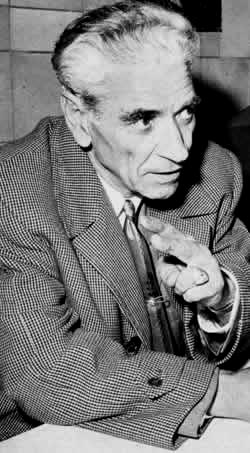
By 1960 Adamski appeared gaunt, weak and ailing. |
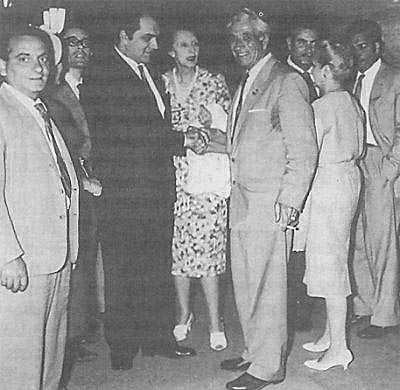
Adamski after a public lecture in the late 1950s. Note the cigarette and the fact that he has sweated completely through his suit coat. |
Adamski's final book, Flying
Saucers Farewell (1961) is a scrapbook-like hodge-podge
actually compiled by several of Adamski's assistants. In the
last 5 years of his life, Adamski managed to alienate almost
every one of his remaining followers by filling his monthly
mail-circulated newsletter with increasingly comical claims,
such as that he was off to Saturn for a week to attend an
invitation-only conference for Cosmic Masters of Wisdom like
himself. Those followers not offended by his initial claim
were aghast at his followup claim that he had decided to
travel to the conference, not via space ship, but using astral
projection, while his body remained behind to be protected by
his aides!
After showing the same tired set of saucer photos for more than a decade, Adamski was apparently persuaded finally to try something new. Just before his death of a heart attack in Maryland on April 23, 1965, Adamski made some very short, very goofy-looking color 8 mm movies of Scout Ships darting randomly and erratically over a wooded landscape... moving much like blowing scraps of paper, or large insects.
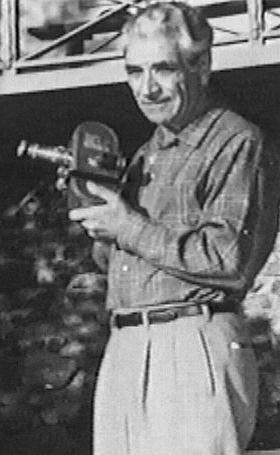 |
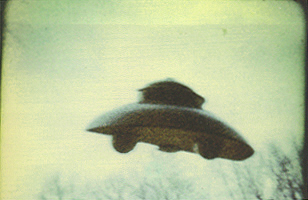
A single frame from Adamski's best-known 1965 8 mm movie of a scout-ship model. The weird apparent bending of the saucer is in fact a warping of the thick, multilayer Dynacolor emulsion; the same warping is seen in background trees and vegetation in the other two films. Adamski owned a 16 mm movie camera, seen at left, but these films were made with an 8 mm camera borrowed from a follower, Mrs. Redeffer. A brief but correct discussion of how Adamski made the film can be found here. |
While a very tiny remnant of the original Adamski cult still survives in the US, he seems to be best remembered today in Europe and Japan. If he is remembered at all, by the world at large, it is still for the photos he published in 1953's Flying Saucers Have Landed,which he was careful to copyright individually, and for which his one or two surviving followers retain the copyright to this day. Because of the copyright, the photos are seldom reproduced, and difficult to find posted anywhere on the Internet, which ironically serves to keep Adamski's current modest fame to a minimal level. A fair idea of what the photos were like can be found here— on a page featuring both Adamski originals and some imitations by others. Other photos are posted here. Adamski's original photos from the early 1950s seem to show a light fixture, complete with three ordinary incandescent light-bulbs that are half-concealed by a circular plate. To me it looks like the removable top of some cylindrical object, the lower part of which was heated by the bulbs, at least one of which appears to be tinted red. Perhaps it was indeed the top of a Sears Chicken Brooder, as many claimed at the time the photos were first published. In fact, famed rocket engineer Walther Riedel pointed out to James Moseley in December of 1953 that examination of one of Adamski's photos with a microscope readily reveals the familiar GE trademark on one of the bulbs. [See p. 69 of Moseley's Shockingly Close to the Truth (Prometheus, NY, 2002).]
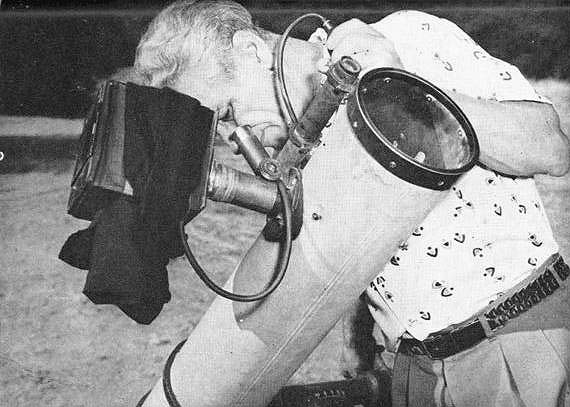
Adamski with the 6-inch Newtonian reflector and sheet-film camera given to him by a follower. By racking the eyepiece to the limit of its tube, it was easy for Adamski to take photos of small floodlit saucer models indoors using essentially the same setup as for astronomical photos outdoors.
When I read Adamski's first book in late 1953 at the tender age of 13, I instantly recognized that the basic features of Adamski's Scout Ship were borrowed closely from Frank Scully's 1950 book, Behind the Flying Saucers, a hoax account of the finding of three crashed flying saucers in the deserts of Arizona and New Mexico by military and industrial expeditions. The three-ball landing gear and many other features of Adamski's saucers seem to be inspired by the not-very-detailed descriptions of Scully's imaginary saucers. Adamski personally knew Scully and con-man Silas Newton, who invented the hoax, and they are even acknowledged indirectly at the end of Flying Saucers Have Landed.
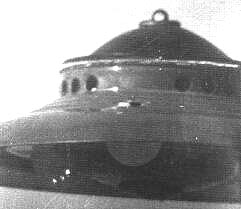
Note the infrared chicken-brooder bulb serving as one of three “ball” landing gear, and also note the reflections of three floodlights from that bulb. The photo was obviously taken indoors. Some suppressed photos show the outer rim of the “saucer” to have a big dent on one side. Note also the absence of glass in the “portholes.” |
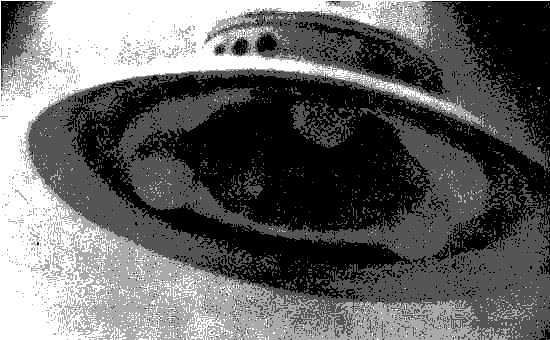 |
Strangely, or not so strangely, Adamski's mythology directly inspired only one movie, Britain's Stranger From Venus (1954) based on a screen treatment by Desmond Leslie himself. It is an imitation of the 1951 US film, The Day the Earth Stood Still, rewritten to make the connection with Adamski's Venusian mythology.
Two Adamski followers, Townsend T. Brown and Agnew Bahnson, built an exact copy of Adamski's Scout Ship in the late 1950s, about the same size (a foot to a foot and a half in diameter), with magnets placed as specified by Adamski. They claimed to be surprised when it just sat there, not taking off by itself.
The Venusian Adamski first encountered was named Orthon, who himself became the Jesus-figure of a religious cult started in England in 1961 by Richard Grave. The British cult spun off a Danish satellite, led by Knud Weiking. The cults attained a brief celebrity in 1967 with their predictions of the eminent end of the world, with Orthon of course offering the only hope of salvation.
Some other “Venusians” who made personal appearances at Flying Saucer Conventions in the late 1950s and early 1960s include Viviann Venus (with authentic girl-next-door looks), the handsome Valiant Thor, and much later, the exotically beautiful Omnec Onec. None of them claimed to know Orthon. Adamski's South African follower Elizabeth Klarer, in the late 1950s, was one of the very first to claim to have been abducted by space aliens; she related how Adamski-style space brothers had taken her to a planet orbiting Alpha Centauri, how one had become her lover, how she had given birth to a child, and then returned to earth with the child remaining behind to be raised properly as a Cosmic Master of Wisdom. An amusing and reliable volume covering all the classic 1950s “contactees” and their very, very strange relationships is Shockingly Close to the Truth, by James W. Moseley and Karl T. Pflock (Prometheus, NY, 2002). Moseley is one of the very few, perhaps the only one, who personally met and talked with all the strange or gullible people who were prominent in 1950s and 1960s flying saucerdom. Another good recent book about Adamski is How to Make the Most of a Flying Saucer Experience, by Professor Solomon (Top Hat Press, 1998). See also In Advance of the Landing, by Douglas Curran (Abbeville Press, 1985, 2001). Here's a brief on-line biography of Adamski. There is also available an e-book about Adamski's life, which can be downloaded here.

 |
Authentic Adamski footage of a Venusian scout ship? Well, maybe not. |
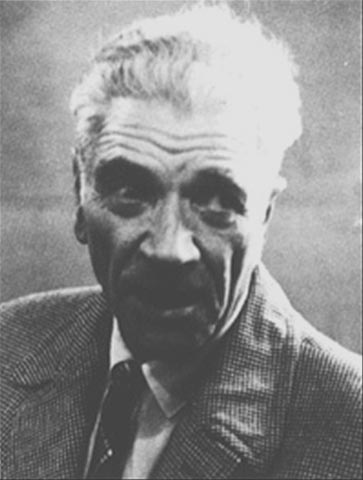 |
←Was it all worth it, George?
Adamski looks totally exhausted on one of his speaking
tours. The stress of these tours might well have
shortened his life. In addition, some who knew him
personally tell me he was a heavy smoker and a very
heavy drinker. However, he still lived to the age of 74.
|
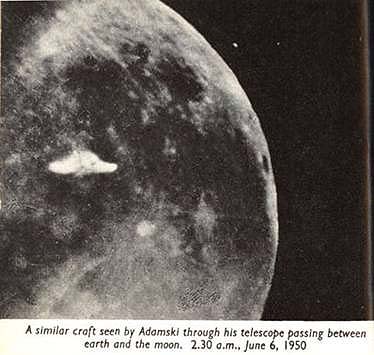 |
